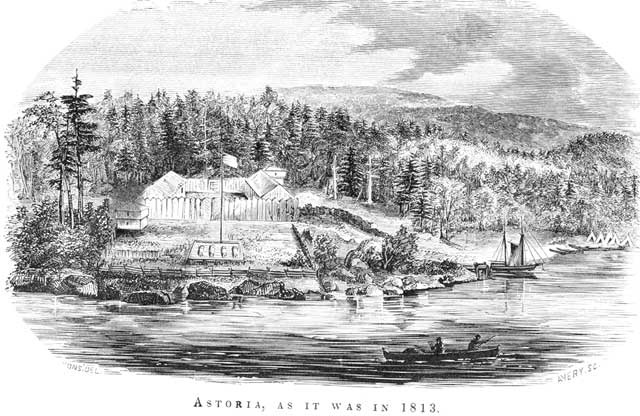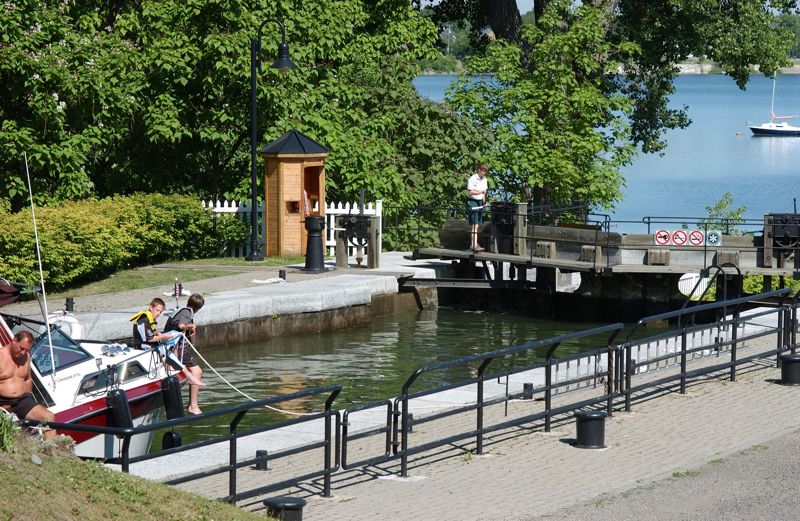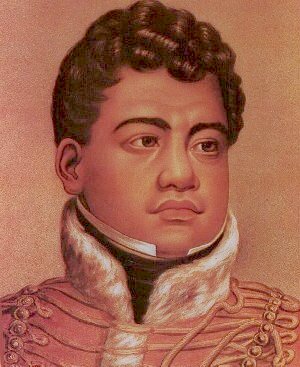|
Г‰tienne Lucier
Étienne Lucier, né Lussier, (June 9, 1786 – March 8, 1853) was a French-Canadian fur trader active primarily in the Pacific Northwest. He was hired by John Jacob Astor's Pacific Fur Company and sent to the region to help establish Fort Astoria. Later he became a settler in the Willamette Valley. Lucier attended the Champoeg Meetings and was one of few French-Canadians or "Canadiens" to vote for the Provisional Government of Oregon, an American and Canadian civil authority for the valley. He is credited with becoming the first European descendant farmer within the modern state of Oregon. Early life Étienne Lucier was born on June 9, 1786, at Boucherville in Chambly County, Quebec. His parents were Michel Lussier and Marie Victoire Edeline Delisle. His god parents were Etienne Lasourde and Marie Anne Laubeil according to the entries in the register of the parish church. Other western explorers with ties to Boucherville include Jacques Denoyon, the family Gaultier de la Veren ... [...More Info...] [...Related Items...] OR: [Wikipedia] [Google] [Baidu] |
Chambly, Quebec
Chambly () is an Greater Montreal, off-island suburb of Montreal in southwestern Quebec, Canada. It is located in the Montérégie region, inland from the South Shore (Montreal), South Shore of the Saint Lawrence River. It was formed from the merger in 1965 of Fort-Chambly (formerly Chambly-Canton prior to 1952) and the old city of Chambly (formerly Chambly-Basin prior to 1952, and earlier sometimes called Bassin-de-Chambly). History Descendants of European immigrants have lived in Chambly since the 17th century, but Chambly was not incorporated as a city until 1965. Samuel de Champlain passed through the area that came to be the site of the town of Chambly, QC, in 1609., when he wrote the following in his journal: Fort Chambly was captured by American forces on October 20, 1775, during the Invasion of Canada (1775), American Invasion of Canada of 1775–76, it was held until the spring of 1776 when it was evacuated and burned, as the Americans retreated southward to Fort ... [...More Info...] [...Related Items...] OR: [Wikipedia] [Google] [Baidu] |
German-Americans
German Americans (, ) are Americans who have full or partial German ancestry. According to the United States Census Bureau's figures from 2022, German Americans make up roughly 41 million people in the US, which is approximately 12% of the population. This represents a decrease from the 2012 census where 50.7 million Americans identified as German. The census is conducted in a way that allows this total number to be broken down in two categories. In the 2020 census, roughly two thirds of those who identify as German also identified as having another ancestry, while one third identified as German alone. German Americans account for about one third of the total population of people of German ancestry in the world. The first significant groups of German immigrants arrived in the British colonies in the 1670s, and they settled primarily in the colonial states of Pennsylvania, New York, and Virginia. The Mississippi Company of France later transported thousands of Germans from Eu ... [...More Info...] [...Related Items...] OR: [Wikipedia] [Google] [Baidu] |
North West Company
The North West Company was a Fur trade in Canada, Canadian fur trading business headquartered in Montreal from 1779 to 1821. It competed with increasing success against the Hudson's Bay Company in the regions that later became Western Canada and Northwestern Ontario. With great wealth at stake, tensions between the companies increased to the point where several minor armed skirmishes broke out, and the two companies were forced by the British government to merge. Before the Company After the French landed in Quebec in 1608, independent French-Canadian traders commonly known as spread out and built a fur trade empire in the St. Lawrence River, St. Lawrence basin. The French competed with the Dutch (from 1614) and English (1664) in New York and the English in Hudson Bay (1670). Unlike the French who traveled into the northern interior and traded with First Nations in their camps and villages, the English made bases at trading posts on Hudson Bay, inviting the indigenous people t ... [...More Info...] [...Related Items...] OR: [Wikipedia] [Google] [Baidu] |
War Of 1812
The War of 1812 was fought by the United States and its allies against the United Kingdom of Great Britain and Ireland, United Kingdom and its allies in North America. It began when the United States United States declaration of war on the United Kingdom, declared war on Britain on 18 June 1812. Although peace terms were agreed upon in the December 1814 Treaty of Ghent, the war did not officially end until the peace treaty was ratified by the 13th United States Congress, United States Congress on 17 February 1815. AngloAmerican tensions stemmed from long-standing differences over territorial expansion in North America and British support for Tecumseh's confederacy, which resisted U.S. colonial settlement in the Old Northwest. In 1807, these tensions escalated after the Royal Navy began enforcing Orders in Council (1807), tighter restrictions on American trade with First French Empire, France and Impressment, impressed sailors who were originally British subjects, even those who ... [...More Info...] [...Related Items...] OR: [Wikipedia] [Google] [Baidu] |
Columbia River
The Columbia River (Upper Chinook language, Upper Chinook: ' or '; Sahaptin language, Sahaptin: ''Nch’i-Wà na'' or ''Nchi wana''; Sinixt dialect'' '') is the largest river in the Pacific Northwest region of North America. The river headwater, forms in the Rocky Mountains of British Columbia, Canada. It flows northwest and then south into the U.S. state of Washington, then turns west to form most of the border between Washington and the state of Oregon before emptying into the Pacific Ocean. The river is long, and its largest tributary is the Snake River. Columbia River drainage basin, Its drainage basin is roughly the size of France and extends into seven states of the United States and one Canadian province. The fourth-largest river in the United States by River flow, flow, the Columbia has the greatest flow of any river into the eastern Pacific. The Columbia and its tributaries have been central to the region's culture and economy for thousands of years. They have been use ... [...More Info...] [...Related Items...] OR: [Wikipedia] [Google] [Baidu] |
Wilson Price Hunt
Wilson Price Hunt (March 20, 1783 – April 13, 1842) was an early pioneer and explorer of the Oregon Country in the Pacific Northwest of North America. Employed as an agent in the fur trade under John Jacob Astor, Hunt organized and led the greater part of a group of about 60 men on an overland expedition to establish a fur trading outpost at the mouth of the Columbia River. The Astorians, as they have become known, were the first major party to cross to the Pacific after the Lewis and Clark Expedition. Biography Historical records refer to Hunt both as "William" and as "Wilson."Fur Trade Explorers Originally from |
Kanaka (Pacific Island Worker)
Kanakas were workers (a mix of voluntary and involuntary) from various Pacific Islands employed in British colonies, such as British Columbia (Canada), Fiji, Solomon Islands, Vanuatu, Papua New Guinea, and Queensland (Australia) in the 19th and early 20th centuries. They also worked in California (United States) and Chile (see also Easter Island and the Rapa Nui). "Kanaka" originally referred only to Native Hawaiians, from their own name for themselves, ''kДЃnaka К»ЕЌiwi'' or ''kДЃnaka maoli'', ''kДЃnaka'' meaning "man" in the Hawaiian language. In the Americas in particular, native Hawaiians were the majority; but Kanakas in Australia were almost entirely Melanesian. In Australian English "kanaka" is now avoided outside of its historical context, as it has been used as an offensive term. Australia According to the ''Macquarie Dictionary'', the word "kanaka", which was once widely used in Australia, is now regarded in Australian English as an offensive term for a Pacific I ... [...More Info...] [...Related Items...] OR: [Wikipedia] [Google] [Baidu] |
Native Hawaiians
Native Hawaiians (also known as Indigenous Hawaiians, KДЃnaka Maoli, Aboriginal Hawaiians, or simply Hawaiians; , , , and ) are the Indigenous Polynesian people of the Hawaiian Islands. HawaiК»i was settled at least 800 years ago by Polynesians who sailed from the Society Islands. The settlers gradually became detached from their homeland and developed a distinct Hawaiian culture and identity in their new home. They created new religious and cultural structures, in response to their new circumstances and to pass knowledge from one generation to the next. Hence, the Hawaiian religion focuses on ways to live and relate to the land and instills a sense of community. The Hawaiian Kingdom was formed in 1795, when Kamehameha the Great, of the then-independent island of HawaiК»i, conquered the independent islands of OК»ahu, Maui, MolokaК»i, and LДЃnaК»i to form the kingdom. In 1810, KauaК»i and NiК»ihau joined the Kingdom, the last inhabited islands to do so. The Kingdom recei ... [...More Info...] [...Related Items...] OR: [Wikipedia] [Google] [Baidu] |
British People
British people or Britons, also known colloquially as Brits, are the citizens of the United Kingdom, the British Overseas Territories, and the Crown dependencies.: British nationality law governs modern British citizenship and nationality, which can be acquired, for instance, by descent from British nationals. When used in a historical context, "British" or "Britons" can refer to the Ancient Britons, the Celtic languages, Celtic-speaking inhabitants of Great Britain during the British Iron Age, Iron Age, whose descendants formed the major part of the modern Welsh people, Cornish people, Bretons and considerable proportions of English people. It also refers to those British subjects born in parts of the former British Empire that are now independent countries who settled in the United Kingdom prior to 1973. Though early assertions of being British date from the Late Middle Ages, the Union of the Crowns in 1603 and the creation of the Kingdom of Great Britain in 1707 triggered ... [...More Info...] [...Related Items...] OR: [Wikipedia] [Google] [Baidu] |
English Canadian
English Canadians (), or Anglo-Canadians (), refers to either Canadians of English ethnic origin and heritage or to English-speaking or Anglophone Canadians of any ethnic origin; it is used primarily in contrast with French Canadians. Canada is an officially bilingual country, with English and French official language communities. Immigrant cultural groups ostensibly integrate into one or both of these communities, but often retain elements of their original cultures. The term English-speaking Canadian is sometimes used interchangeably with English Canadian. Although many English-speaking Canadians have strong historical roots traceable to England or other parts of the British Isles, English-speaking Canadians have a variety of ethnic backgrounds. They or their ancestors came from various Celtic, European, Asian, Caribbean, African, Latin American, and Pacific Island cultures, as well as French Canada and North American Aboriginal groups. In addition to the terms "Engli ... [...More Info...] [...Related Items...] OR: [Wikipedia] [Google] [Baidu] |
Iroquois
The Iroquois ( ), also known as the Five Nations, and later as the Six Nations from 1722 onwards; alternatively referred to by the Endonym and exonym, endonym Haudenosaunee ( ; ) are an Iroquoian languages, Iroquoian-speaking Confederation#Indigenous confederations in North America, confederacy of Native Americans in the United States, Native Americans and First Nations in Canada, First Nations peoples in northeast North America. They were known by the French during the Colonial history of the United States, colonial years as the Iroquois League, and later as the Iroquois Confederacy, while the English simply called them the "Five Nations". Their country has been called wikt:Iroquoia, Iroquoia and Haudenosauneega in English, and '':fr:Iroquoisie, Iroquoisie'' in French. The peoples of the Iroquois included (from east to west) the Mohawk people, Mohawk, Oneida people, Oneida, Onondaga people, Onondaga, Cayuga people, Cayuga, and Seneca people, Seneca. After 1722, the Iroquoian-sp ... [...More Info...] [...Related Items...] OR: [Wikipedia] [Google] [Baidu] |
Voyageurs
Voyageurs (; ) were 18th- and 19th-century French and later French Canadians and others who transported furs by canoe at the peak of the North American fur trade. The emblematic meaning of the term applies to places (New France, including the and the ) and times where that transportation was over long distances, giving rise to folklore and music that celebrated voyageurs' strength and endurance. They traversed and explored many regions in what is now Canada and the United States. Despite their fame, their lives were arduous and not nearly as glamorous as folk tales made out. For example, they had to be able to carry two bundles of fur over portages. Some carried four or five, and there is a report of a voyageur carrying seven bundles for half a mile.Mike Hillman, "La Bonga: The Greatest Voyageur" Boundary Waters Journal Magazine, Summer 2010 Issue, pp 20–25 Hernias were common and frequently caused death. Most voyageurs started working in their early twenties and continued w ... [...More Info...] [...Related Items...] OR: [Wikipedia] [Google] [Baidu] |








